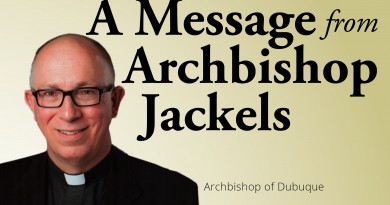Bringing back the feast of ‘Our Lady of Expectation’
By Sean M. Wright
Special to The Witness
Time was when the cultural celebration of Christmas began the evening of Dec. 24 and ended the evening of Jan. 6: 12 days. As late as the 1940s, it was still traditional to wait until Christmas Eve to set up the family tree.
When my sister Helen — still the best, most loving big sister ever — was born exactly one week before Christmas, 1942, Mom and Dad began to hang the wreath, string lights and decorate the tree on the 18th just to make her birthday more special. It became a family tradition.
[swpm_protected]
“Mom and Dad would chuckle when neighbors walked up as they were hanging the outdoor Christmas lights on my birthday,” Helen recalls, “concerned about ‘rushing the season,’ as they put it.”
“Rushing the season” is a forcefully redolent phrase not heard today. It’s too quaint an idea when many homes are already decked with Christmas lights at the start of football season.
Only a lifetime ago, it was considered bad form to rush the season by setting up Christmas store displays before Thanksgiving. The accepted practice for retailers nowadays is to sweep out the Halloween décor, skip Thanksgiving altogether and proceed directly to Christmas. The resplendent wonder of Almighty God incarnate as a helpless baby gets lost in the welter of two months of incessant commercialism.
This lengthy celebration is rather paradoxical recalling how leaders of the early church opposed celebrating the birth of Jesus. Not until 336 was the Mass of Christ’s Nativity celebrated in Rome on Dec. 25, nine months after the feast of the Annunciation, already long established as having occurred on March 25.
So what does all this have to do with the feast of Our Lady of the Expectation?
As Lent came into its own in the 500s, some bishops thought it wrong to celebrate joyous feast days during the season of sorrow and renunciation. The Annunciation, therefore, was often transferred to the Thursday after Easter, an arrangement bishops at the 10th Synod of Toledo (636) didn’t much care for. Thus, in Spain, the date of the Annunciation was solemnized a week before Christmas on Dec. 18.
The church eventually determined that celebrating an occasional joyous feast during Lent did not compromise the season’s overall penitential tone. Restoring the Annunciation to March 25, Spain’s bishops continued to honor Christ’s fetal humanity on Dec. 18 by venerating Blessed Mary’s pregnancy, her divine expectation, as a prelude to Christmas. Las Posadas, memorializing Mary and Joseph seeking shelter in Bethlehem, grew out of the observance of this feast.
The feast of Our Lady of the Expectation was celebrated worldwide for centuries but was removed from the church’s universal calendar in 1914, although it remained as a votive Mass to be celebrated at a priest’s discretion. Still, today, in Spain, Portugal, Italy and Poland, the feast of the Virgin’s divine pregnancy remains a compulsory Advent Mass for Dec. 18.
The attributes of Mary found in paintings under the title “Our Lady of the Expectation” are worth considering, as described by Father Marian Zalecki, of the National Shrine of Our Lady of Czestochowa: “Our Blessed Lady, well advanced in pregnancy, is portrayed in the highest dignity of her divine motherhood. Her whole posture suggests how she remains wholly consumed in contemplation of her Son’s existence under her heart.”
Restoring this feast to the universal church could be of much significance in the present age. As a day uniquely devoted to all expectant mothers, its octave culminating with Christmas, the festival of children, mothers and their unborn babies, could be placed under the patronage of the Blessed Virgin and Jesus, the fetal Son of God in her womb. As an unmistakable sign that unborn babies are to be regarded as real persons, such patronage would serve a gentle yet potent rebuke to the monied interests providing abortion on demand.
On Dec. 18, mothers delighting in their pregnancies and the babies in their wombs, might take as their model the Lady Mary, the unmarried girl of Nazareth who courageously permitted the Holy Spirit to make her womb a temporary home, a tabernacle, for Jesus. A special blessing for them would reflect a profound truth: as Jesus took flesh in Mary’s womb, so babies enfleshed in their own mothers’ wombs can be redeemed from sin, learning to know, love and serve their creator.
Thanking God for their as yet unborn children, mothers and fathers could pray the joyful words of Isaiah 45:8, the Rorate Coeli, the church’s entrance antiphon for Dec. 18: “Drop down dew, ye heavens, from above, and let the skies rain down the Righteous One! Let the earth be opened and bud forth a Savior!”
Instead of rushing the season by putting up colored lights and finery in November, Catholics can be encouraged to delay stringing their twinkling Christmas lights and festal décor until the feast of Our Lady of the Expectation, as a sign of our baptismal solidarity as children of the light with Jesus, the only-begotten Son of God, the radiant Light of the World.
Sean M. Wright, an Emmy-nominated writer, is a catechist for the Archdiocese of Los Angeles and is a member of the RCIA team for Our Lady of Perpetual Help parish in Santa Clarita. He answers comments sent him at Locksley69@aol.com.
[/swpm_protected]
[swpm_login_form]




